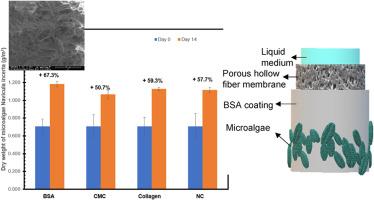Biofilm cultivation and air blow harvesting of Navicula incerta on PVDF hollow fiber membrane with different biocoatings
IF 5.8
2区 生物学
Q1 AGRICULTURAL ENGINEERING
引用次数: 0
Abstract
Biofilm cultivation reduced the harvesting and drying costs in microalgae agronomy. Although microalgae can be cultivated and harvested using the porous membrane, the surface properties restrict cell adhesion and removal. In this study, the porous polyvinylidene fluoride (PVDF) hollow fiber membranes with different biocoatings were used to grow Navicula incerta at the air-liquid interface. Fourier transform infrared spectra showed the characteristic peaks of the coating materials, while the water contact angle measurement revealed that bovine serum (BSA) increased surface hydrophobicity most significantly. The zeta potential further proved that BSA also increased the adhesion energy, leading to the highest growth rate of N. incerta of 67.3 % but a slight drop in air blow harvesting efficiency of 78.73 %. BSA boosted astaxanthin accumulation in microalgae up to 4.77 μg/mL, enhancing cell proliferation. SEM images displayed microalgae cells with extracellular organic matter attached to different biocoatings. The membrane porosity was not significantly affected even after cultivation and harvesting.

不同生物涂层的PVDF中空纤维膜上水蛭的生物膜培养及吹收
生物膜栽培降低了微藻农艺的收获和干燥成本。虽然微藻可以利用多孔膜进行培养和收获,但其表面特性限制了细胞的粘附和去除。本研究采用具有不同生物涂层的聚偏氟乙烯(PVDF)多孔中空纤维膜,在气液界面上培养杂交Navicula incerta。傅里叶变换红外光谱显示了涂层材料的特征峰,而水接触角测量结果表明,牛血清(BSA)对涂层表面疏水性的提高最为显著。zeta电位进一步证明了BSA也增加了粘附能,使得无尾蓟的生长速率最高,达到67.3%,但风吹收集效率略有下降,为78.73%。牛血清白蛋白可促进微藻虾青素积累达4.77 μg/mL,促进细胞增殖。扫描电镜图像显示微藻细胞与细胞外有机物附着在不同的生物涂层上。栽培和收获后对膜孔隙度影响不显著。
本文章由计算机程序翻译,如有差异,请以英文原文为准。
求助全文
约1分钟内获得全文
求助全文
来源期刊

Biomass & Bioenergy
工程技术-能源与燃料
CiteScore
11.50
自引率
3.30%
发文量
258
审稿时长
60 days
期刊介绍:
Biomass & Bioenergy is an international journal publishing original research papers and short communications, review articles and case studies on biological resources, chemical and biological processes, and biomass products for new renewable sources of energy and materials.
The scope of the journal extends to the environmental, management and economic aspects of biomass and bioenergy.
Key areas covered by the journal:
• Biomass: sources, energy crop production processes, genetic improvements, composition. Please note that research on these biomass subjects must be linked directly to bioenergy generation.
• Biological Residues: residues/rests from agricultural production, forestry and plantations (palm, sugar etc), processing industries, and municipal sources (MSW). Papers on the use of biomass residues through innovative processes/technological novelty and/or consideration of feedstock/system sustainability (or unsustainability) are welcomed. However waste treatment processes and pollution control or mitigation which are only tangentially related to bioenergy are not in the scope of the journal, as they are more suited to publications in the environmental arena. Papers that describe conventional waste streams (ie well described in existing literature) that do not empirically address ''new'' added value from the process are not suitable for submission to the journal.
• Bioenergy Processes: fermentations, thermochemical conversions, liquid and gaseous fuels, and petrochemical substitutes
• Bioenergy Utilization: direct combustion, gasification, electricity production, chemical processes, and by-product remediation
• Biomass and the Environment: carbon cycle, the net energy efficiency of bioenergy systems, assessment of sustainability, and biodiversity issues.
 求助内容:
求助内容: 应助结果提醒方式:
应助结果提醒方式:


